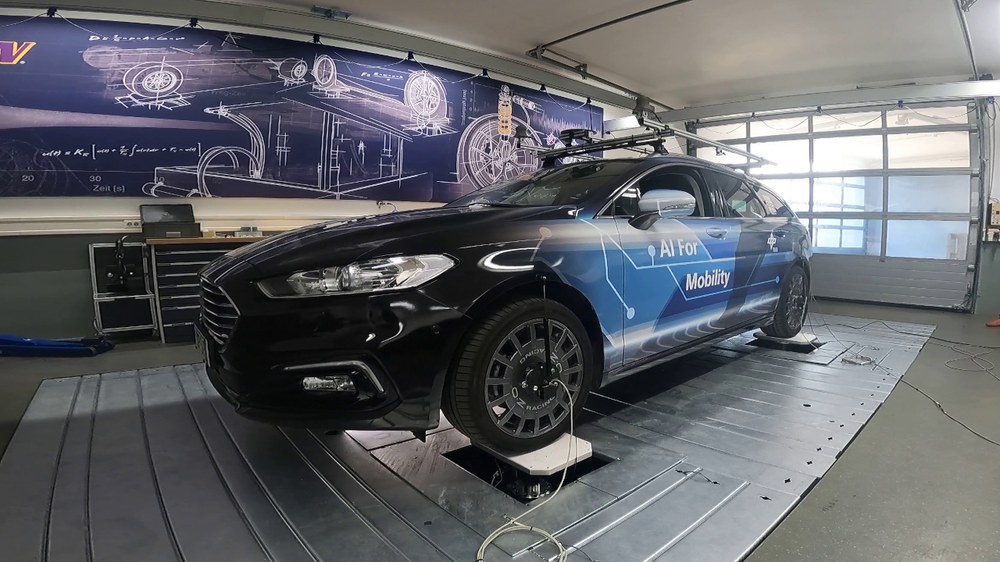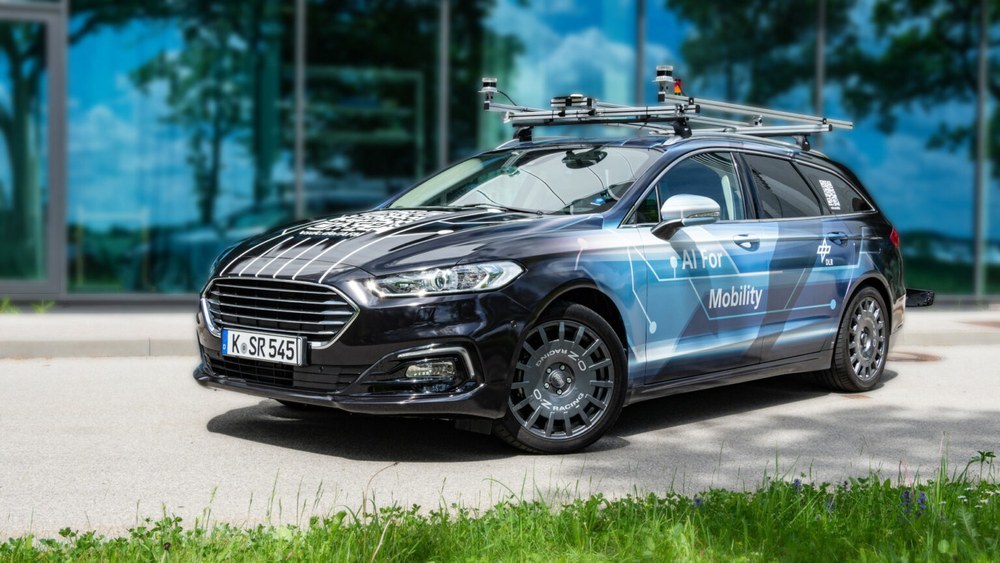The vehicle is equipped with a large number of sensors to record the status and internal sensor values as well as environmental variables such as road conditions and the environmental scenario. The vehicle sensors are recorded synchronously on a rapid control prototyping system. For certain research projects, the collected data is uploaded to a cloud system that enables centralised and cross-vehicle control methods. The extensive measuring equipment transforms the vehicle into a powerful data collector that enables the development of new methods for condition estimation. For a simulative analysis with a digital twin, a true-to-the-original vehicle model is required. For this purpose, a multi-domain multi-body system (MBS) vehicle model was implemented in Modelica.
Components in the AFM
The AFM is equipped with the following sensors and powerful CPU and GPU systems:

- Full Drive-By-Wire Kit (DBW)
The drive-by-wire (DBW) kit enables real-time control of the steering, acceleration und braking thus allowing the vehicle to be driven automatically. The system is seamless integrated into the vehicle electronics and communication network, which allows to control all chassis series actuators. - High Performance Rapid Control Prototyping (RCP) System
The RCP system is a powerful platform optimized for in-vehicle use. The system provides numerous interfaces for information transfer, e.g. several CAN and Ethernet connectors as well as a multi I/O board to generate and measure both analog and digital signals. All control algorithms that are used to control the DBW kit run on the system. Furthermore, the central data logging with Cloud connectivity takes place here. - Multi GPU accelerated AI Computing Plattform
The AI stereo camera and the high resolution lidar sensor are connected to the high performance AI-computer (GPU based) platform to be processed (sensor fusion, lane/sign/object recognition,..) and the relevant data for the controllers is given to the RCP system. - State of the Art AI Stereo Camera System
A high resolution AI assisted stereo camera (GMSL connection) is mounted on the roof rack which records the environment and output RGB and depth images. It features a 9-DoF sensors for spatial and positional awareness. - High Resolution Lidar Sensors
The 360° lidar sensors is mounted on the roof rack at the front of the vehicle for scanning surrounding objects and correlate the information to other sensors e.g. the camera or radar. - Prototype Radar Sensor System (under development)
Up to three radar sensors will be integrated in the front of the vehicle which communicate the radar signatures to AI platform where a seamless object detection and tracking is carried out. - Custom Prototype Semi-active Dampers Control System
The controlled semi-active dampers regulate the forces, which control the chassis body as well as the wheel load fluctuations. - Contact Free Road Weather Sensor
The high precision optical sensor continuously scans the road surface and records various parameters such as the surface temperature or the water film height. - High Precision IMU/GNSS System
A high-precision 6D Inertial Measurement Unit (IMU) is installed close to the center of gravity to capture all components of vehicle motion. Two roof antennas enable the fusion of global navigation satellite system (GNSS) measurements. - Real-time Drive Torque and Steering Force Measurement via Strain-gauge Sensors
A calibrated strain gauge measuring system is installed on the drive shafts and tie rods. Therefore, drive torques and tie rod forces can be measured during driving maneuvers. - Over Ground Optical Speed Sensor
The optical sensor scans the road surface to measure the vehicle’s overground velocity. Both longitudinal and lateral velocity can be measured precisely. On the basis of these measurements the vehicle’s side-slip angle is determined. - Mobile Network Connection (5G)
For online controller parameter variation and remote test-drive supervision the vehicle’s network can be accessed via an 5G connection. It also enables the real-time data upload and connection to cloud based applications. - Mobile Base Station for dGPS Signal Generation
To increase the accuracy of the satellite measurements (GNSS), a mobile differential GPS (dGPS) base station provides correction data to the IMU/GNSS platform installed in the vehicle. - Intelligent Power Distribution System (PDS)
The PDS manages the power supply of all additional electrical components in the vehicle. Due to a big number of installed sensors and actuators, their power supply is required to be intelligently controlled.

AFM Experiments on a Vertical Dynamics Test Rig for AI-based Control Algorithms
Your consent to the storage of data ('cookies') is required for the playback of this video on Youtube.com. You can view and change your current data storage settings at any time under privacy.
As part of the AI For Mobility project, a hybrid production vehicle was chosen as the base platform as it has a fully wired vehicle architecture. As most prototype vehicles have the disadvantage that they are not road-legal, they can only be used on closed-off test sites. The AFM has a special road licence for certain operating modes and therefore has a wider range of possible applications in experiments on the public road network.

